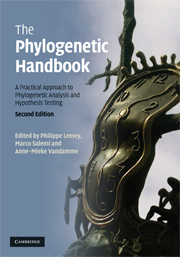Book contents
- Frontmatter
- Contents
- List of contributors
- Foreword
- Preface
- Section I Introduction
- Section II Data preparation
- Section III Phylogenetic inference
- 4 Genetic distances and nucleotide substitution models
- 5 Phylogenetic inference based on distance methods
- 6 Phylogenetic inference using maximum likelihood methods
- 7 Bayesian phylogenetic analysis using MRBAYES
- 8 Phylogeny inference based on parsimony and other methods using PAUP
- 9 Phylogenetic analysis using protein sequences
- Section IV Testing models and trees
- Section V Molecular adaptation
- Section VI Recombination
- Section VII Population genetics
- Section VIII Additional topics
- Glossary
- References
- Index
9 - Phylogenetic analysis using protein sequences
from Section III - Phylogenetic inference
Published online by Cambridge University Press: 05 June 2012
- Frontmatter
- Contents
- List of contributors
- Foreword
- Preface
- Section I Introduction
- Section II Data preparation
- Section III Phylogenetic inference
- 4 Genetic distances and nucleotide substitution models
- 5 Phylogenetic inference based on distance methods
- 6 Phylogenetic inference using maximum likelihood methods
- 7 Bayesian phylogenetic analysis using MRBAYES
- 8 Phylogeny inference based on parsimony and other methods using PAUP
- 9 Phylogenetic analysis using protein sequences
- Section IV Testing models and trees
- Section V Molecular adaptation
- Section VI Recombination
- Section VII Population genetics
- Section VIII Additional topics
- Glossary
- References
- Index
Summary
THEORY
Introduction
In addition to nucleotide sequences, protein sequences are frequently used for the analysis of evolutionary relationships and, as we will learn below, they are often preferred for constructing phylogenetic trees. As DNA and RNA sequences are subject to gradual change over evolutionary time resulting from the incorporation of mutations, insertions or deletions, the translated products of genes will inevitably undergo similar evolutionary changes. Not all genetic mutations in the genes will lead to mutations in the corresponding proteins, but when amino acid mutations occur, they may affect the protein in three possible ways. They may be harmful (deleterious) to the protein, in which case purifying selection will eliminate them; they may be neutral, which means that they will have no effect on the function of the protein; or they may be beneficial. As neutral mutations are not penalized by natural selection, they can accumulate over time according to the process of genetic drift (see Chapter 13). Beneficial mutations usually become fixed more rapidly in the population due to positive selection. As a result, sequences of orthologous proteins from two species that have diverged from a common ancestor will differ only slightly when there has been little time for mutations to occur, whereas more differences will have accumulated when ample time has passed.
Different proteins may evolve at highly different rates. The so-called “house-keeping” proteins evolve rather slowly because they catalyze essential functions within cells.
Information
- Type
- Chapter
- Information
- The Phylogenetic HandbookA Practical Approach to Phylogenetic Analysis and Hypothesis Testing, pp. 313 - 342Publisher: Cambridge University PressPrint publication year: 2009
Accessibility standard: Unknown
Why this information is here
This section outlines the accessibility features of this content - including support for screen readers, full keyboard navigation and high-contrast display options. This may not be relevant for you.Accessibility Information
- 6
- Cited by
